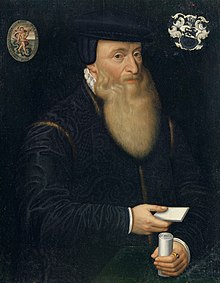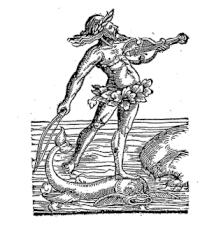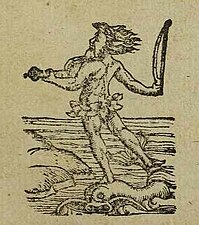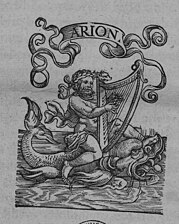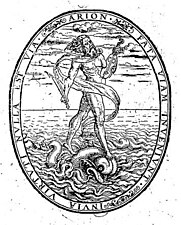lingvo.wikisort.org - Researcher
Johannes Oporinus (also Johannes Oporin; Latinised from the original German name: Johannes Herbster or Hans Herbst) (25 January 1507 – 7 July 1568) was a humanist printer in Basel.
This article includes a list of references, related reading or external links, but its sources remain unclear because it lacks inline citations. (August 2022) |
Life
Johannes Oporinus, the son of the painter Hans Herbst, was born in Basel.[1] He completed his academic training in Strasbourg and Basel. After working as a teacher in the Cistercian convent of St. Urban, he returned to Basel, where he worked as a proofer in the shop of Johann Froben, the most important Basel printer of the early 16th Century. In addition, he taught at the Basel Latin school from 1526. In 1527 he was temporarily famulus to the physician Paracelsus. [1]
From 1538, Oporinus was the professor for greek and latin at the University of Basel.[1] In 1542 he resigned his academic post to devote himself full-time to his printing workshop. [1] In addition, he completed a medical studies. In 1567, he sold his printshop to the Gemuseus family
Personal life
He was married four times, each time with a widow. The third wife was a sister of the publisher Johan Hervagius the younger (died 1564)[2] and the fourth a sister of Basilius Amerbach.[1] He died deeply in debt on the 7 July 1568 and all his possessions were confiscated by the authorities in order to pay his creditors.[3] He had an extensive library of 4000 books, which was auctioned.[4] His manuscript collection and his extensive correspondence are preserved in the Basel University Library.[citation needed]
Publications
This section needs additional citations for verification. (August 2022) |
After he published a Latin version of the Gesta Danorum in 1534, entitled Saxonis grammatici Danorum historiae libri XVI, in 1542/43 [citation needed] he printed the first Quran in latin edited by Theodor Bibliander[1] (the first printed Koran worldwide) from a translation made by Robert of Ketton in Spain between 1142 and 1143 by command of Peter the Venerable. For the Koran, Oporinus had to enter into prison for a short while.[1] difficulties. The Basel city council wanted to prevent the publication but yielded due to the intervention of Martin Luther and Philip Melanchthon.
The most important publication of his workshop was the anatomical atlas De humani corporis fabrica by the humanist physician Andreas Vesalius, in 1543.[5] In October 1546 a book on the assassination of the Spanish Protestant Juan Díaz, entitled Historia vera de morti sancti viri Ioannis Diazii Hispanics [...] by Claudium Senarclaeum, was published by his workshop, which is attributed to Francisco de Enzinas.
In addition, his press published numerous polemical theological works, classics, and historiographical works. His fine knowledge of ancient languages served the quality of consistently correct textual editions. Oporinus later printed a work on church history by Matthias Flacius Illyricus: Catalogus testium veritatis (1556) and the first eleven (1559–1567) of Wigand's thirteen Magdeburg Centuries. In 1559 he published the complete editio princeps of Diodorus Siculus' Bibliotheca historica. Before he died, he planned to publish the first Bible in the Spanish language, for which Casiodoro de Reina paid 400 guilders in advance.[6] But Oporinus died before the bible was able to go into print.[6]
Oporinus' mark
Looking at title page or at the colophon of an Oporinus edition, the printer's device shows the mythological lyre player Arion of Lesbos, which is supported by a Dolphin on the sea. There are more variant forms of it, some are shown below.
References
- Werthmüller, Hans (1980-01-01). Tausend Jahre Literatur in Basel (in German) (1 ed.). Basel: Birkhäuser Basel. p. 127. ISBN 3-7643-1173-8.
- Klemm, Heinrich (1884). Beschreibender catalog des Bibliographischen museums. Getty Research Institute. Dresden, H. Klemm. pp. 232–233.
- Gilly, Carlos (2001). Die Manuskripte in der Bibliothek des Johannes Oporinus (in German). Basel: Schwabe Verlag. p. 9.
- Gilly, Carlos (2001).p.10
- Kusukawa, Sachiko. "De humani corporis fabrica. Epitome". Cambridge Digital Library. Retrieved 1 August 2016.
- Gilly, Carlos (2001).pp.18–19
Further reading
- Harry Clark (1984), The Publication of the Koran in Latin: A Reformation Dilemma. The Sixteenth Century Journal, Vol.15, No.1, (Spring 1984), pp. 3–12. Available via JSTOR
- Carlos Gilly (2001), Die Manuskripte in der Bibliothek des Johannes Oporinus: Verzeichnis der Manuskripte und Druckvorlagen aus dem Nachlass Oporins anhand des von Theodor Zwinger und Basilius Amerbach erstellten Inventariums. (Schriften der Universitätsbibliothek Basel 3). Schwabe, Basel, ISBN 3-7965-1088-4
- Martina Hartmann (2001), Humanismus und Kirchenkritik. Matthias Flacius Illyricus als Erforscher des Mittelalters. (Beiträge zur Geschichte und Quellenkunde des Mittelalters 19) Thorbecke, Stuttgart, ISBN 3-7995-5719-9
- Martina Hartmann, Arno Mentzel-Reuters (2005), Die Magdeburger Centurien und die Anfänge der quellenbezogenen Geschichtsforschung. Ausstellung. Monumenta Germaniae Historica (MGH), Munich.
- Andreas Jociscus (1569) Oratio De Ortv, Vita, Et Obitv Ioannis Oporini Basiliensis, Typographicoru[m] Germaniæ Principis. Rihelius, Strasbourg (digitized, also contains the Catalogvs Librorvm Per Ioannem Oporinium excusorum)
- Oliver K. Olson (2002) Matthias Flacius and the survival of Luther’s Reform. (Wolfenbütteler Abhandlungen zur Renaissanceforschung 20). Herzog August Bibliothek, Wolfenbüttel, ISBN 3-447-04404-7
- Karl Steiff (1887), "Oporinus, Johannes", Allgemeine Deutsche Biographie (ADB) (in German), vol. 24, Leipzig: Duncker & Humblot, pp. 381–387
- Martin Steinmann (1967) Johannes Oporinus. Ein Basler Buchdrucker um die Mitte des 16. Jahrhunderts. (Basler Beiträge zur Geschichtswissenschaft 105). Helbing & Lichtenhahn, Basel.
- Martin Steinmann (1969), Aus dem Briefwechsel des Basler Druckers Johannes Oporinus. Basler Zeitschrift für Geschichte und Altertumskunde 69 (1969): 104–203
External links
- Sample pages from Vesalius' De humani corporis fabrica
- Digitized Magdeburg Centuries
- Oporinus, Johannes in German, French and Italian in the online Historical Dictionary of Switzerland.
- Digital edition of De humani corporis fabrica; Epitome published by Oporinus in 1543, in Cambridge Digital Library
Другой контент может иметь иную лицензию. Перед использованием материалов сайта WikiSort.org внимательно изучите правила лицензирования конкретных элементов наполнения сайта.
WikiSort.org - проект по пересортировке и дополнению контента Википедии
